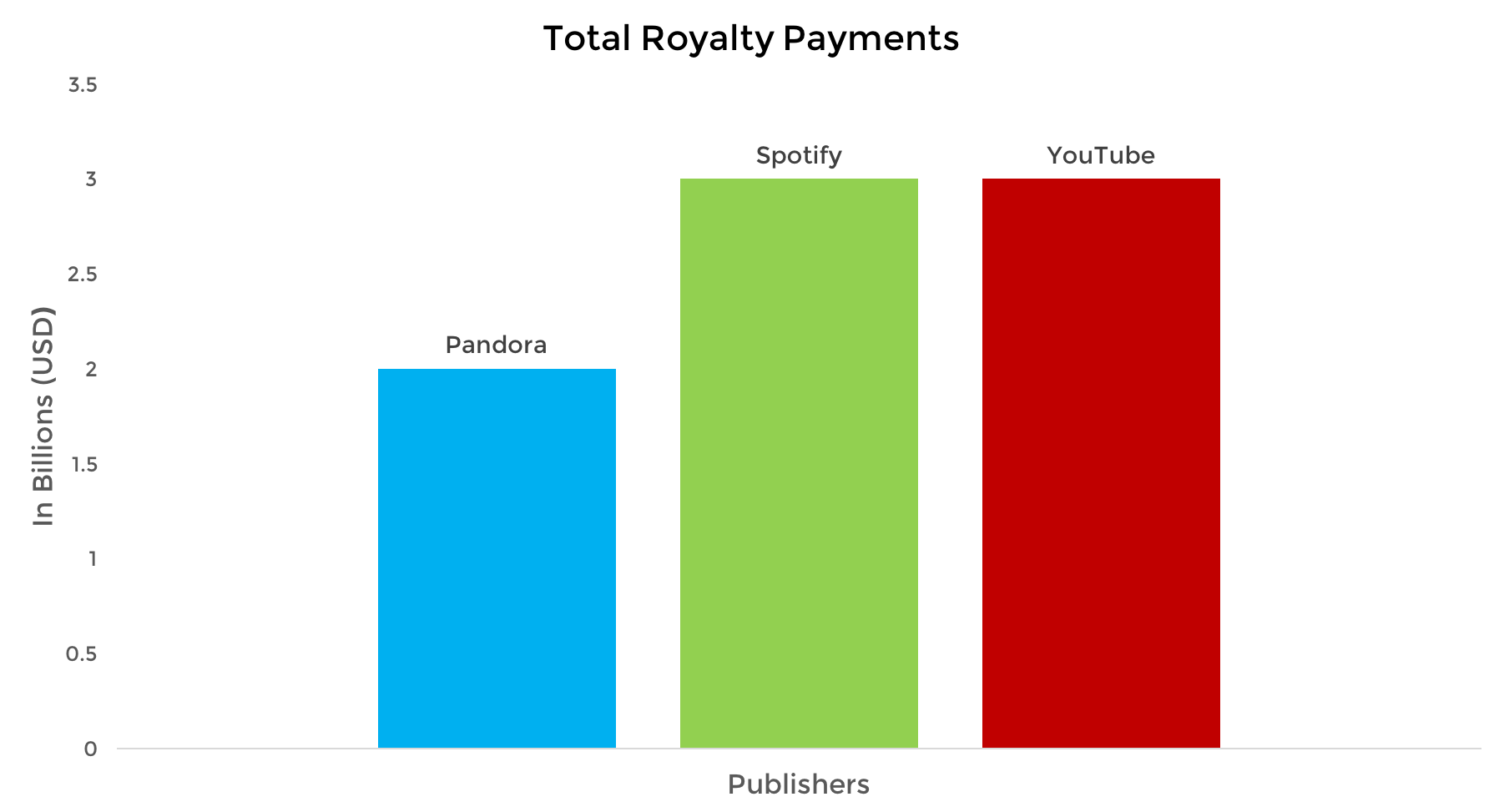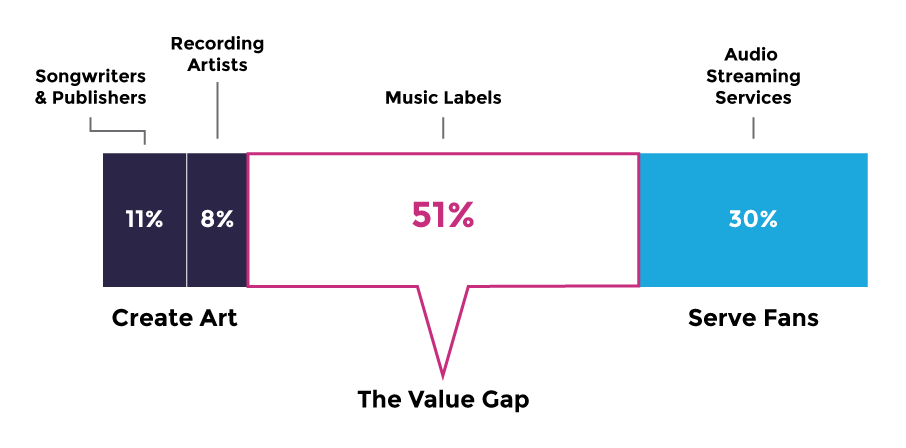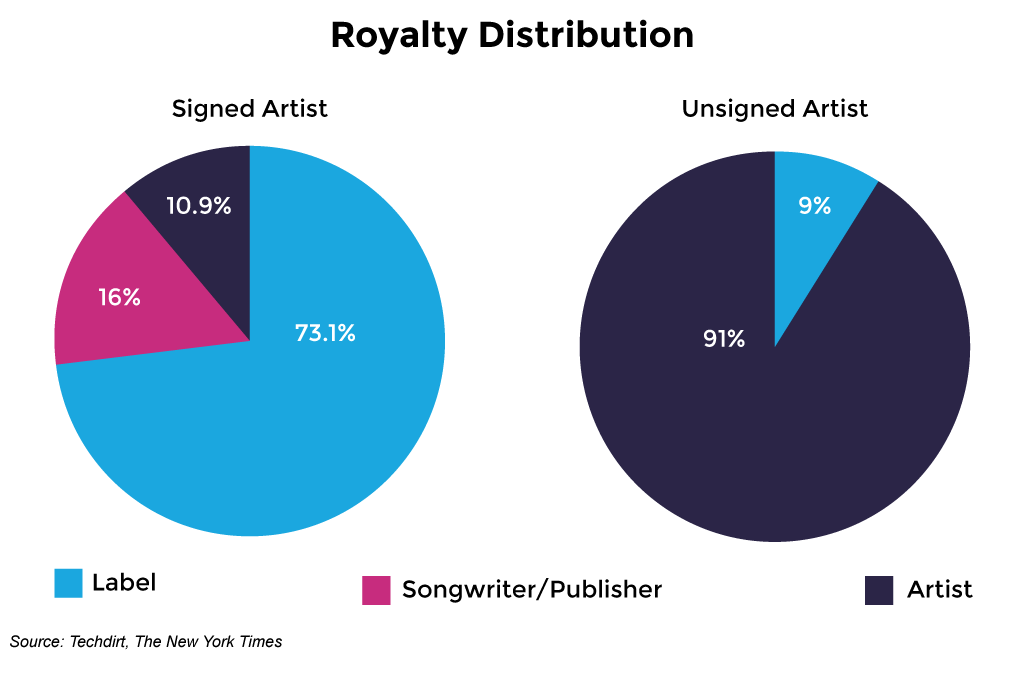A continuous string of comments from record labels and a few musicians might make you think that streaming services somehow don’t pay artists for their work. This is factually incorrect as a few recent announcements from Pandora, Spotify and YouTube attest. There is a value gap in music that exists between music labels and musicians. The value delivered from streaming services to royalty holders is strong and growing fast. If the artist has retained the rights to their music, they are doing pretty well. If they haven’t, the middlemen (i.e. music label executives) are doing well in their place.
Pandora Pays out $2 Billion in Royalties
There was something misleading in Pandora’s announcement last week, “Pandora Hits $2 Billion in All-Time Royalties for Artists and Songwriters.” I have to assume the number is correct, but how much of that trickled down to artists and songwriters is another question. Earlier research shows that music labels generally have one-sided agreements with recording artists and retain 73% of royalty pay-outs. This suggests that only $540 million of Pandora royalties actually made it into the pockets of the creators. It also means $1.46 billion went into the bank accounts of music label executives and other functionaries that have little or no impact on the creative process.
Artists like Perrin Lamb are unsigned. As a result, Mr. Lamb retains all but 9% of his royalty checks. The balance goes to a processing firm that streamlines the royalty management for him. Other artists that are fortunate enough to own their music labels—I’m talking about you Jay-Z—keep the payments as they have avoided the music label middlemen or joined them and signed their own artists. Good for them. It is hard to believe that music labels create 73% of the value of a song, but every time you buy one that is who receives most of your dollars.
Kudos to Pandora for building such a large and loyal listening base that they have generated $2 billion in royalty payments for the industry and $500 million is just the last nine months. Two years ago Pandora was the most commonly referenced “problem” by music label executives when it came to monetization. However, it is clear that Pandora doesn’t actually have “free” listening from a royalty holder perspective. Every song spin generates a payment and they add up quickly.
Spotify Has Paid out More than $3 Billion in Royalties
Last year, the music label executives shifted their scorn from Pandora and trained it primarily on Spotify. Again, their claims of “free” listening doesn’t mean royalty holders don’t get paid. Consumers may not need to pay dollars to listen to Spotify, but they do pay with their time by listening to ads. Even if the service decides to run zero ads, the royalty holders still get paid.
Spotify’s website currently reports that $3 billion in royalties have been paid out to date. It also suggests that $300 million were paid out in just the first quarter of 2015. That data was first made public in June 2015. Since that time Spotify data suggests that they have increased subscribers by 50% and ad-supported listeners have risen by 27%.
Given the growth in Spotify’s listener base, it is safe to assume that the company paid out over $1 billion in royalties last year alone and we should expect some data soon that points to $4 billion in royalty payments. Of Spotify’s 100 million active listeners, 70 million choose the ad-supported option. It’s numbers like these that confirm the conclusion that streamers like Spotify are actually saving the music industry from economic collapse. It is not clear that there would be another revenue source to make up for declining music purchases if streaming options weren’t available.
YouTube Pays out $3 Billion in Royalties
So this year’s target of music label derision has shifted to YouTube. Each year, the target shifts but the charge is the same, “streamers are taking advantage of musicians.” In a 2014 interview at the Midem conference in Cannes, France, YouTube’s Vice President of Content Tom Pickett revealed that over $1 billion in royalties had been paid to artists. Rolling Stone reported at the time that, “music business sources say it ranges from 60 cents to $2 for every 1,000 views.” Pickett was quoted as saying, “There is money being generated in this ad-supported model. It is going to artists.”

More recently, a Google filing with the U.S. Copyright Office states that, “Google has sent over $3 billion to the music industry.” YouTube’s Content ID solution which enables rights holders to search YouTube for copyrighted music has generated over $1 billion alone. Content ID enables rights holders to request the infringing material be removed from YouTube or they can opt to place advertising alongside the content and receive royalty payments. There may be some in the music industry that don’t like the contracts they negotiated with YouTube in years’ past, but they are clearly generating income from their royalty rights.
The Rolling Stone article includes this quote: “YouTube income keeps going up. It has gone up every single accounting period,” says Josh Grier, an attorney who represents Wilco, Bob Mould, Ryan Adams and others. “Those who I made deals for a few years ago, and [who] bought into the game, are getting money.”
Where You Stand Depends on Where You Sit
The phrase, “where you stand depends on where you sit,” was coined by Rufus E. Miles Jr. while working in the Bureau of the Budget in the administration of U.S. President Harry Truman. It suggests your position is dictated largely by the interests of the organization you represent.
Music label executives are apt to criticize their customers, in this case the streamers, as a means of applying pressure to improve their own economics. They are not thinking of optimizing the entire system, but rather their personal take in a monetary transaction. Nor are they thinking about the well-being of artists. If they were thinking of recording artists, they have a simple remedy. They can start paying them more than 13 cents on every royalty dollar they receive. No. That is not likely to happen.
The Value Gap is Consumed by Music Labels
The music labels and artists entered into contract willingly and there is little incentive to simply cede an economic advantage secured during negotiations. Similarly, where the music labels and their industry association mouthpieces (e.g. RIAA and IFPI) stand is to better their own economics with artists and with customers. That is the role of a middleman. In the music industry simple math suggests the labels take in about 51% of all streaming dollars. The streaming services get about 30% to cover their costs of building, sustaining and serving their audiences, and recording artists and songwriters get about 19%. It’s a good industry to be a middleman. 
So the next time you hear a music label executive or RIAA functionary claiming that there is a “value gap” between creators of music and the streaming services that distribute it, you know that gap has been filled nicely by those very music labels gobbling up every dollar they can claim. That is where they stand because they sit in the middle. Where do you stand?
[su_button style=”flat” size=”6″ background=”#D73C90″ radius=”0″ url=”https://go.pardot.com/emailPreference/e/35552/300″ target=”_blank”]Subscribe to XAPP Blog[/su_button]
Related Posts
Royalty Rates Rise 21%, Quest for Higher Ad Rates Begins
RIAA Misleads While Advertising Delivers 54% of Internet Radio Revenue
New York Times Misled by Recording Industry on Internet Radio

